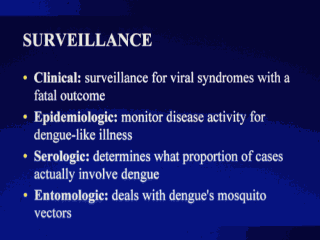Search inside of Supercourse and lectures in HTML and PPT format
|
|
|
|
front |1 |2 |3 |4 |5 |6 |7 |8 |9 |10 |11 |12 |13 |14 |15 |16 |17 |18 |19 |20 |21 |22 |23 |24 |25 |review |
 |
A surveillance system must be simple, yet comprehensive, in its structure and in its operation and flexible enough to allow the incorporation of new data. Dengue prevention and control programs must be in line with more effective surveillance as an early warning system that can predict epidemic dengue, and combining this with mosquito control measures - including community-based measures - to reduce
Aedes aegypti densities. An effective dengue surveillance system must address the disease from both a clinical and an entomological perspective as well as consider the virologic, epidemiologic, and serologic aspects that are useful in an active surveillance system. Surveillance for dengue and dengue hemorrhagic fever/dengue shock syndrome can be either active or passive. Currently, most surveillance for these diseases has been passive - that is, it has depended upon case reports from the medical community that have recognized dengue-like illnesses. In most tropical countries where dengue transmission is reported, the surveillance system is of the passive type, with health authorities waiting until transmission is recognized by the medical services and detected through the routine reporting system. This type of surveillance is typically very insensitive because of the low index of suspicion on the part of the physicians and the difficulties inherent in clinical differential diagnosis. Additionally, many patients treat themselves at home and do not seek medical treatment. Thus, by the time dengue cases are detected and reported by the medical community in a passive surveillance system, substantial transmission has already occurred and even may have peaked. By then it is generally too late to have much impact upon epidemic transmission, even though intensive mosquito control measures may be implemented. The alternative strategy is active surveillance, which entails actively monitoring dengue infections in the community at all times. |